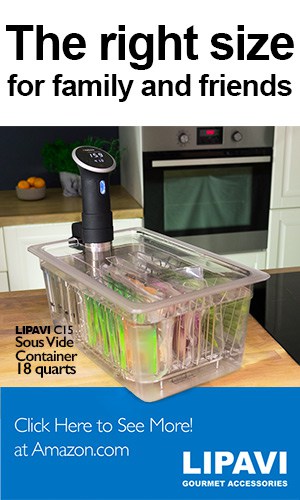-
Sous Vide Time and Temperatures
Sous Vide Time and Temps
Sous Vide Time and Temps
Sous Vide Temps
- All Sous Vide Temperatures
- Sous Vide Beef Temperatures
- Sous Vide Chicken Temperatures
- Sous Vide Duck Temperatures
- Sous Vide Fish Temperatures
- Sous Vide Vegetables Temperatures
- Sous Vide Infusions Temperatures
- Sous Vide Lamb Temperatures
- Sous Vide Pork Temperatures
- Sous Vide Shellfish Temperatures
- Sous Vide Turkey Temperatures
- Recipes Recipes Recipes Recipes
- Getting Started Guides Getting Started Guides Getting Started
- Equipment and Tools Equipment and Tools Equipment Equipment and Tools
- More Resources More Resources Resources More Resources

This article is a part of my free Exploring Sous Vide email course. If you want to discover how to consistently create amazing food using sous vide then my course is exactly what you're looking for. For a printed version of this course, you can purchase my Exploring Sous Vide cookbook.
Is Sous Vide Safe? Key Safety Guidelines
Click here to get great sous vide content via email
This post may contain affiliate links. Read more.
Written by Jason Logsdon
If there's one thing you need to know when cooking, whether it is using sous vide or any other technique, it is what procedures are important for you follow to be safe when preparing your food. I've put together a list of the top safety points in regards to sous vide. If you follow them, you won't get sick according to the US Government, Harold McGee, Douglas Baldwin, and Serious Eats, whose more scientific-based leads I follow.
Note: If you prefer, you can jump right to the Lesson Recap.
Before I start though, I think it's important to point out that sous vide is no more or less safe than other methods of cooking. There's a lot of talk about the safety of sous vide, but it's just as easy to make yourself sick by under-cooking a chicken in the oven, or not pasteurizing grilled pork. So don't be intimidated, once you know a few rules of thumb you will be all set
1) Never Cook Food Below 130°F (54.4°C) For Longer Than a Few Hours

From a safety standpoint, food cooking at temperatures below 130°F (54.4°C) isn't cooking at all, it's just being warmed. The bacteria we are trying to remove from cooking thrive from around 40°F (4.4°C) to 126°F (52.2°C), and they stop growing but don't start dying quickly until around 130°F (54.4°C). That range is known as the "danger zone" (cue Top Gun music) and it's often referred to in food safety circles.
Note that sometimes the danger zone is even considered to be up to 140°F (60°C) but that is based on building in a margin of error for restaurants, not the actual growth and death of the pathogens.
Cooking a piece of meat below 130°F (54.4°C) is the equivalent to letting it sit on your counter. It's fine for a few hours but it's not something you'll want to do all day. A generally accepted safe overall time in the danger zone, from leaving the fridge through cooking and eating is generally considered 3 to 4 hours.
Any piece of food that needs cooked longer than a few hours should be cooked at a minimum temperature of 130°F (54.4°C). If there is only one thing to remember about cooking in general, and sous vide cooking specifically, it's to not have your food between 40°F (4.4°C) and 130°F (54.4°C) for more than a few hours.
Note: For a really good look at this process, as well as many other scientific underpinnings of cooking, I highly recommend On Food and Cooking by Harold McGee.
2) Do Not Just Trust Your Circulator's Temperature

Most sous vide circulators are very precise and the temperature does not fluctuate much at all. However, they can sometimes become uncalibrated and heat to the wrong temperature, usually only by a degree or two.
If you push the limits of the danger zone, that degree could be the difference between safe food and unsafe food.
Because of this potential calibration issue, it's good to double check the temperature of your circulator every few weeks with another thermometer. I also recommend cooking a degree or two above the danger zone for all cooks over a few hours unless you have just calibrated your machine. If you must push the danger zone, I highly suggest getting a second thermometer that you can use to double check the temperature of the water.
3) Always Pasteurize Certain Foods
Sometimes when cooking you want to ensure your food is pasteurized, not just heated through. This is particularly important for chicken and poultry, blade-tenderized steaks, and low quality fish.
Warning Note: It is very important to always pasteurized food when you are serving it to immuno-compromised people. This generally includes pregnant women, the elderly, babies, or those with weak immune systems.
Pasteurization occurs when the food is held at a specific temperature for a certain amount of time. The higher the temperature is, the faster the food is pasteurized. Even though the temperatures in the chart below range from barely medium-rare to medium-well they are all equally safe to eat when cooked for the indicated times.

These times all start once the middle of the piece of meat has reached the indicated temperature. I will talk more about cooking by thickness in the next lesson, but for now you can use my thickness ruler to determine how long it takes to reach the indicated temperature.
- Once Heated, Beef is Pasteurized at:
- 130°F (54.4°C) for 2 hours
- 133°F (56.1°C) for 1 hour
- 138°F (58.9°C) for 18 minutes
- 145°F (62.8°C) for 4 minutes
- Once Heated, Chicken is Pasteurized at:
- 140°F (60.0°C) for 30 minutes
- 145°F (62.8°C) for 12 minutes
- 150°F (65.6°C) for 4 minutes
In the past the "recommended cooking times" that the US Government put out were designed to produced pasteurized food instantly. For example, at the generally recommended chicken temperature of 165°F (73.8°C) it will be pasteurized in less than a second. That short amount of time is why the government recommends it, so if a cook pulls a piece of chicken off the grill right as it hits the temperature, it'll still be safe to eat. But chicken cooked to 165°F (73.8°C) and held for one second, is just as safe as chicken cooked to 140°F (60.0°C) and held for 30 minutes.
Showcase Recipe: For a good example of chicken pasteurization, you can look at my Sous Vide Chicken Recipe with Bulgar Salad and Za'atar Onions. It discusses the pasteurization times for chicken and general cooking times.
4) Scientists Agree, Plastic Is Fine

A main concern of sous vide safety is cooking in plastic and whether or not this is a dangerous practice. Many scientists and chefs believe that cooking in food-safe, BPA-free plastic at these low temperatures does not pose any risk, the temperature is about equivalent to leaving a bottle of water in your car, or in a semi-truck during transport in summer. This included Ziploc freezer bags, sous vide bags, and most food-safe plastics.
However, I find it hard to believe that we know everything about how plastic reacts to heat, water, our bodies, and the environment. As such, I encourage you to read up on the safety of plastic in sous vide and plastic in general and come to your own conclusions about the safety of using these techniques.
Note: For some more information, here is Modernist Cuisine discussing it and Chef Steps.
I hope this will at least give you some various perspectives on it and you can make an informed opinion of your own!
Have some questions about sous vide safety? Let me know in the comments or on the Exploring Sous Vide Facebook group.
Lesson Recap
In this lesson we discussed the four key pieces of safety information to keep in mind when cooking with sous vide. They were:
Keys to Sous Vide Safety
- Never Cook Food Below 130°F (54.4°C) For Longer Than a Few Hours
- Do Not Just Trust Your Circulator's Temperature
- Always Pasteurize Certain Foods
- Scientists Agree, Plastic Is Fine
If you keep those key points in mind, you shouldn't have any health issues related to sous vide, or other methods of cooking!
I also shared some key links with you, namely
Sous Vide Safety Links
- On Food and Cooking
- My Sous Vide Chicken Breast Recipe
- Modernist Cuisine Discussing Plastic
- Chef Steps Discussing Plastic
Do you know anyone that is struggling with sous vide and would find this information helpful? Why not do them a favor and send them a link to this Exploring Sous Vide email course or get them a printed version of this course!
Course Link:
 Thanks again and happy cooking!
Thanks again and happy cooking!
Jason Logsdon, Amazing Food Made Easy
This article is a part of my free Exploring Sous Vide email course. If you want to discover how to consistently create amazing food using sous vide then my course is exactly what you're looking for. For a printed version of this course, you can purchase my Exploring Sous Vide cookbook.
 This article is by me, Jason Logsdon. I'm an adventurous home cook and professional blogger who loves to try new things, especially when it comes to cooking. I've explored everything from sous vide and whipping siphons to pressure cookers and blow torches; created foams, gels and spheres; made barrel aged cocktails and brewed beer. I have also written 10 cookbooks on modernist cooking and sous vide and I run the AmazingFoodMadeEasy.com website.
This article is by me, Jason Logsdon. I'm an adventurous home cook and professional blogger who loves to try new things, especially when it comes to cooking. I've explored everything from sous vide and whipping siphons to pressure cookers and blow torches; created foams, gels and spheres; made barrel aged cocktails and brewed beer. I have also written 10 cookbooks on modernist cooking and sous vide and I run the AmazingFoodMadeEasy.com website.
Affiliate Disclaimer: Some links on this site might be affiliate links that if used to purchased products I might receive money. I like money but I will not endorse something I don't believe in. Please feel free to directly go to any products I link to and bypass the referral link if you feel uncomfortable with me receiving funds.













